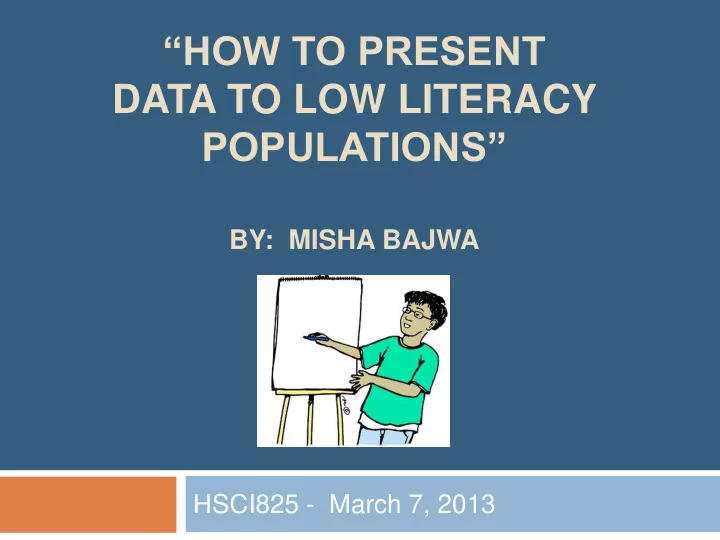

“HOW TO PRESENT DATA TO LOW LITERACY POPULATIONS” BY: MISHA BAJWA HSCI825 - March 7, 2013
Outline Introduction What is Health Literacy? The Message The Audience Communication Strategies: Plain Language & Readability Layout/Design & Visual Data Tools & Resources
Introduction We are living in a high information culture! Need literacy skills in today’s world Health literacy can lead to awareness, empowerment, and self-efficacy
What is Health Literacy? “…ability to read, understand, and act on health care information.” (CHCS, 2000 ) “…ability to make sense of information in any form in which it is presented.” (Nelson & Parvanta, 2011) Types: functional, prose, document, quantitative - health numeracy
Low Health Literacy Affects different types of people (e.g. low income, immigrants, older population) Inability to read and/or interpret health information can lead to poorer health outcomes
Public Health Objectives… Increase health literacy Improve health communication!
Health Communication: The Message Delivers the key health behaviour Data can be written, visual, oral, etc. Keep it CLEAR and SIMPLE “Sticky Idea” easy to understand easy to remember changes opinions/values/behaviour
Health Communication: The Audience Laypersons patients, communities, remote/rural populations, etc. Audience as information processors Assess their knowledge and skills (needs assessment) Know your audience and the context - connect with their values Culturally-competent messaging Engage the audience
Effective Health Communication Strategies Use Plain Language plain language is simple language use active voice and action verbs be less technical and more direct incorporate readability/usability
Effective Health Communication Strategies “living room language” - use ordinary language/analogies to explain complex health processes E.g. Losing Weight Safely (http://www.plainlanguage.gov) Before: The Dietary Guidelines for Americans recommends a half hour or more of moderate physical activity on most days, preferably every day. The activity can include brisk walking, calisthenics, home care, gardening, moderate sports exercise, and dancing. After: Do at least 30 minutes of exercise, like brisk walking, most days of the week.
Effective Health Communication Strategies Assess Readability limit # of words (15 - 20 per sentence) limit # of syllables (< 3 per word) large font, bold words, etc.
Effective Health Communication Strategies Assess Readability (cont’d) Grade 6-7 level on Flesch-Kincaid scale consider English proficiency of the audience pre-test materials with the audience readability checklists
Effective Health Communication Strategies Simple Layout/Design organize key points http://www.cdc.gov/healthliteracy/pdf/simply_put.pdf make data easy to follow use headings, bullets, wide margins, etc. incorporate lots of white space!
Effective Health Communication Strategies Use Visual Data images faster to process than words serve as aids to the text graphs, charts, photographs, drawings, cartoons, etc. keep them simple!
Effective Health Communication Strategies Use Visual Data (cont’d) one message per visual show desired actions vs. undesired ones should be high quality, realistic, and colourful
Effective Health Communication Strategies Some Other Tips: Verbal communication - slow down when speaking; use metaphors and stories Online communication - conduct usability testing for websites Use social networking to access hard-to- reach communities
Effective Health Communication Strategies Some Other Tips (cont’d) : Numeric data use charts, etc. instead of listing statistics Repetition of key points is important Use “show me” or “teach back” techniques to check understanding
Effective Health Communication Strategies Some Other Tips (cont’d) : Clarify: Ask “What questions do you have?” vs. “Do you have any questions?” Collaborate with others to produce effective materials Don’t make assumptions about low literacy populations; maintain adult perspective
Tools & Further Resources Readability tests/formulas: Microsoft Word functions, Fry Index, SMOG, etc. Toolkits about health literacy, plain language, creating easy-to- understand materials CDC public health image database http://phil.cdc.gov/phil/home.asp
Conclusion KEEP IT SIMPLE.
Resources Kerr, D. (2010). Poor numeracy: the elephant in the diabetes technology room. J Diabetes Sci Technol. , 4(6): 1284-1287. Kickbusch, I. S. (2001). Health literacy: Addressing the health and education divide. Health Promotion International , 16(3), 289-297. Parvanta, C., Nelson, D.E., Parvanta, S.A., Harner, R.N. Essentials of Public Health Communication. Mississauga, Ontario: Jones and Bartlett Learning, 2011. Centers for Disease Control and Prevention. (2009). Simply Put: A guide for creating easy-to-understand materials. Retrieved from http://www.cdc.gov/healthliteracy/pdf/simply_put.pdf Center for Health Strategies, Inc. (2005). Health Literacy Fact Sheets. Retrieved from http://www.chcs.org/publications3960/publications_show.htm?doc_id=291711 National Institutes of Health. (2012). Plain Language. Retrieved from http://www.nih.gov/clearcommunication/plainlanguage.htm MedlinePlus. (2013). How to Write Easy-to-Read Health Materials. Retrieved from http://www.nlm.nih.gov/medlineplus/etr.html
Recommend
More recommend